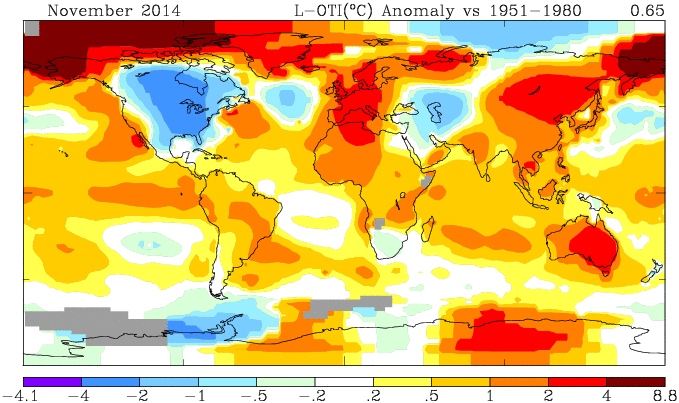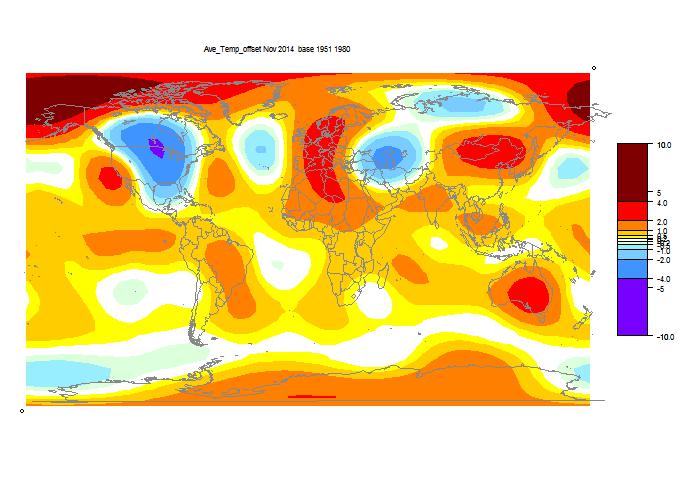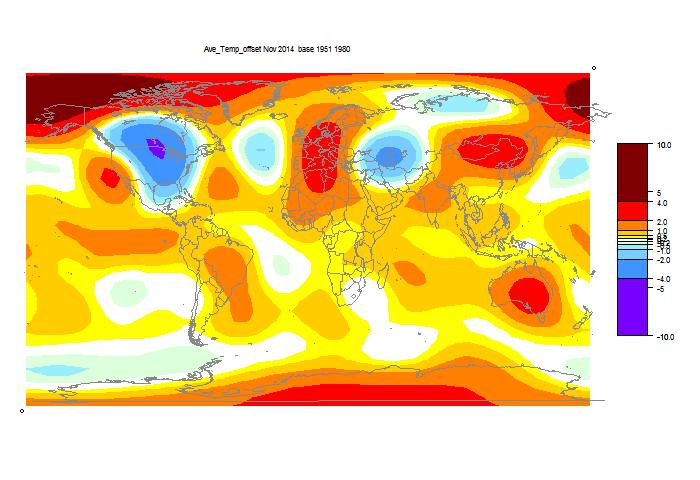As usual, I have also done a TempLS Grid calc. As explained here, I expect the mesh calc to more closely emulate GISS, while the grid calc should be closer to the NOAA and HADCRUT indices. TempLS grid did show a greater reduction, from 0.631°C to 0.519°C.
When NOAA comes out, I'll post on the likelihood of a record this year. The NCEP/NCAR index has been quite cool in December as well, so a GISS record is in the balance. NOAA and HADCRUT are currently ahead by a greater margin, but TempLS suggests may see a greater reduction.
Details of the GISS map for the month, and comparison with TempLS, are below the jump.

And here, with the same scale and color scheme, is the earlier mesh weighted TempLS map:

And finally, here is the TempLS grid weighting map:













I still think December will bounce back. Maybe I'm letting local conditions cloud my judgment. Took my 91-year-old mother to the Japanese Gardens on Friday and she was in her shirtsleeves. In November it was often too cold for her to walk outside.
ReplyDeleteLatest data does show resumed warmth since 10th. Still, that's nearly 1/3 month cool.
DeleteNick, how does GISS look now?
DeleteJCH,
DeleteWarm weather has continued. NCEP/NCAR index average for Dec to 26th is now 0.23; above August and close to September. So I think a record for GISS is quite likely.
We'll soon know. Noticed you added The Science of Doom, who is sounding here lately a bit like Judith Curry, to your roll.
ReplyDeleteJCH,
ReplyDeleteSorry about this going to spam first. Oddly, in the last few weeks (real) spam here has dropped right away. Early in the year it was very bad. The spam catcher must get bored.
SoD has always been on the blogroll. I found his posts very comprehensive, but sometimes went on a bit, so I read them less now. But I think he has done very good work.
Your comment got me checking whether the Wayback Machine is a Moyhu follower. It seems yes. Here is their first, from 2010. The blogroll hasn't changed that much, but some of the activity levels have.
Sorry, never noticed it there before. SoD has added articles recently that are very interesting.
ReplyDeleteAt SoD, the commenter "verbascose" has very interesting things to say:
ReplyDeletehttp://scienceofdoom.com/2014/12/30/natural-variability-and-chaos-seven-attribution-fingerprints-or-shadows/#comment-89785
I am beginning to think that nearly everything pertaining to climate variability is forced.
Yes, it is a very interesting discussion. But he clearly says that while orbit changes etc are (non-anthro) forcings, ENSO and other oscillations are not.
DeleteIn my research POV, there is a strong possibility that ENSO is forced. The fact that ENSO has the word "oscillation" means that something has to trigger it. It can be a periodic forcing, or it can be a stochastic forcing that results in a quasi-periodic resonance.
DeleteIn the end, it may be that ENSO is only slightly more complicated than modeling tidal oscillations, and tides are definitely a forced behavior.
Daily temperatures are also forced. So are seasonal oscillations. The better question is to ask what is not forced.
Except the parts that are caused by magic! WHT - just remember, the SOI today is showing the return of global cooling via an intense La Nina. You're right. This climate shift is apparently being forced by an avalanche of cut-and-paste blog replies that contain exactly the same same papers over and over.
ReplyDeleteYup, the Chief cut-and-paste Engineer says that "Judy’s is a bit of a zoo" --- I wonder why?
ReplyDelete